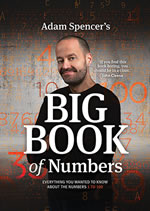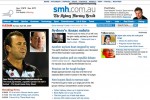Archives → Elsewhere
Growth Mindset. Yes, but…
As I've thought about "Growth Mindset", see also Jo Boaler, I am convinced but then I head into class and walk out unconvinced. That disconnection is helpfully elaborated on in this blog post:
The Math Ceiling: Where’s your cognitive breaking point?
Math with Bad Drawings
Worksheets are not bad… here’s proof
Don Steward shares his excellent worksheets on his blog, Median.
Coordimate on KickStarter
The Coordimate looks like a great idea, currently 80% funded:
Adam Spencer’s Big Book of Numbers
 This holidays I wandered through Adam Spencer's Big Book of Numbers (currently sold out). For teachers, if you purchase from Adam's site, I paid a little extra to also get a Lesson Plans booklet.
This holidays I wandered through Adam Spencer's Big Book of Numbers (currently sold out). For teachers, if you purchase from Adam's site, I paid a little extra to also get a Lesson Plans booklet.
New year reading
How to Avoid Thinking in Math Class is developing into a nice series to take us back into the new school year.
Current State 2
After writing Current State, I read these three articles that all resonated.
A Mathsmas advent calendar
It is worth pointing out that Tanith on her blog, Jellybeans and other Tangents is blogging A Mathsmas Advent – 24 days of maths teaching ideas for the holiday season.
Lesson Prep
Where do you go for maths lessons and good lesson ideas?
Here’s the start of my list, I’m not particularly recommending these sites, just listing them as places to look for ideas.

Mathematician’s Dice
Feeling nerdy? Backing this project on KickStarter will get you a Mathematician’s Dice for just $5 (2 for $10, 4 for $20).
Rather than the boring numbers 1 to 6, these dice have the six most important numbers in mathematics on them — i, 0, 1, φ, e and π!
Letters and Numbers
Jeff of Webmaths points out a new Australian TV show, Letters and Numbers.
End of Term 7
The end of term series of posts are some of the most popular on this site.
Using the web
I just posted on my personal blog about how I use the web, looking at how the various technologies (RSS) and tools (Google Reader, Delicious, Twitter) fit together.
Some graphs are just wrong
Here’s a great example of a graph that is just wrong, the data may be correct, but it has obviously been represented the wrong way. Watch the video…
Classroom Icons
Having found this tip on elearnr.org Doug Belshaw’s blog about using PowerPoint:
Find graphics that represent things you do frequently in lessons (perhaps from clipart) and always use these when doing a similar activity. For example, a pen writing for when it’s time to start work or two people talking for discussion/group work. These help reinforce good habits and aid classroom management.
I went looking for some nice graphics to use.
Confusing with words
I wonder how often maths teachers make confusing statements like this in class:
Single aged pensioners may lose one-third of an expected $30-a-week increase in the May 12 budget. [emphasis mine, front page of smh.com.au on 26th April 2009]
What they actually mean is that the expected increase will be $20.
Chocolate and Maths
Eating chocolate could improve the brain’s ability to do maths.
[full story: telegraph.co.uk
AKA, justifying the use of Freddos in the maths classroom.
See, maths is important
An embarrassing, and slightly funny, example of why Mathematics is important (in this case, being able to read a calendar).
Theatrical Aspect Ratio
Recently Dan Meyer posted his thoughts on the ideal maths textbook, which would actually be a digital archive of very interesting mathematical media
. This is a great idea, and whilst I don’t have a projector in my classroom yet (although fingers-crossed), it would be something that I would buy/subscribe to. Anyway, there was a challenge in this for me: being mindful of the media I consume and the world around me to collect digital bits and pieces that might help explain a mathematical concept (I commented on Dan’s blog that I missed the opportunity to take a picture of 3m³ of dirt I had delivered). The second, to my mind harder, challenge is to take that item and make a meaningful and engaging connection with a concept being taught in class.
Wild About Math!
I’m currently sorting through the many teaching blogs I subscribe to, trying to cull the list. The thing about Maths related blogs that tends to keep them in the list is that Maths teachers generally write more practical posts.
Two fonts - tally and calculator
Two very handy fonts that will help make worksheets and other computer created resources look great.
Number Bowling
Another game, this time for the most basic “technology” in the maths classroom – the calculator.
Pig
I’m trying to build up a collection of maths games for lesson fillers, reward and skills practise.
EAA Mathematics Resources
Here’s a nice page of resources for Mathematics teachers, published via the EAA (Educational Assessment Australia, UNSW).
Report: “Their Space: Education for a digital generation”
In the 16th January 2007 episode of the BBC’s program Digital Planet, Gareth Mitchell talks to the authors of a report about children and technology. The report is titled “Their Space: Education for a digital generation”. It’s a free PDF download. I haven’t read it yet… maybe some reflections in a future post.
New Subscribe to the …
MathsLinksemail newsletter
Get updates…
About
Simon Job — eleventh year of teaching maths in a public high school in Western Sydney, Australia.
MathsClass is about teaching and learning in a maths classroom. more→
Archive
Elsewhere
 @simonjob
@simonjob
updates via  @mathslinks
@mathslinks
Recently read/found.
Being a Vector is not Mutually Exclusive – Ringo Mok
maths vectorsInstagram
Gcf howie_hua maths


